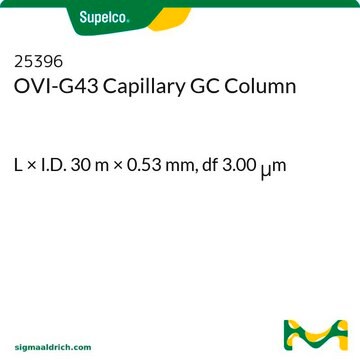24080-U
SUPELCOWAX 10 GC-Kapillarsäule
L × I.D. 30 m × 0.32 mm, df 0.25 μm
Synonym(e):
GC column, PEG, (polyethylene glycol)
About This Item
Empfohlene Produkte
Materialien
fused silica
Agentur
OSHA 52,80
meets requirements for USP G16
Parameter
35-280 °C temperature (isothermal or programmed)
Beta-Wert
320
df
0.25 μm
Methode(n)
gas chromatography (GC): suitable
L × ID
30 m × 0.32 mm
Aktive Matrixgruppe
Bonded; poly(ethylene glycol) phase
Anwendung(en)
agriculture
chemicals and industrial polymers
cleaning products
cosmetics
flavors and fragrances
food and beverages
industrial hygiene
personal care
petroleum
pharmaceutical (small molecule)
Säulenart
capillary polar
Suchen Sie nach ähnlichen Produkten? Aufrufen Leitfaden zum Produktvergleich
Allgemeine Beschreibung
USP-Code: Diese Säule entspricht den Anforderungen von USP G16.
Phase:
- Gebunden
- Poly(ethylenglycol)
- ≤0,32 mm Innendurchmesser: 35 °C bis 280 °C (isothermal oder programmiert)
- ≥0,53 mm Innendurchmesser, <2 μm: 35 °C bis 280 °C (isothermal oder programmiert)
- ≥0,53 mm Innendurchmesser, ≥2 μm: 35 °C bis 250 °C (isothermal oder programmiert)
Anwendung
Sonstige Hinweise
Rechtliche Hinweise
Choose from one of the most recent versions:
Besitzen Sie dieses Produkt bereits?
In der Dokumentenbibliothek finden Sie die Dokumentation zu den Produkten, die Sie kürzlich erworben haben.
Kunden haben sich ebenfalls angesehen
Artikel
Separation of Alcohols and Esters in Spirits using Serially Connected GC Columns
Unser Team von Wissenschaftlern verfügt über Erfahrung in allen Forschungsbereichen einschließlich Life Science, Materialwissenschaften, chemischer Synthese, Chromatographie, Analytik und vielen mehr..
Setzen Sie sich mit dem technischen Dienst in Verbindung.



